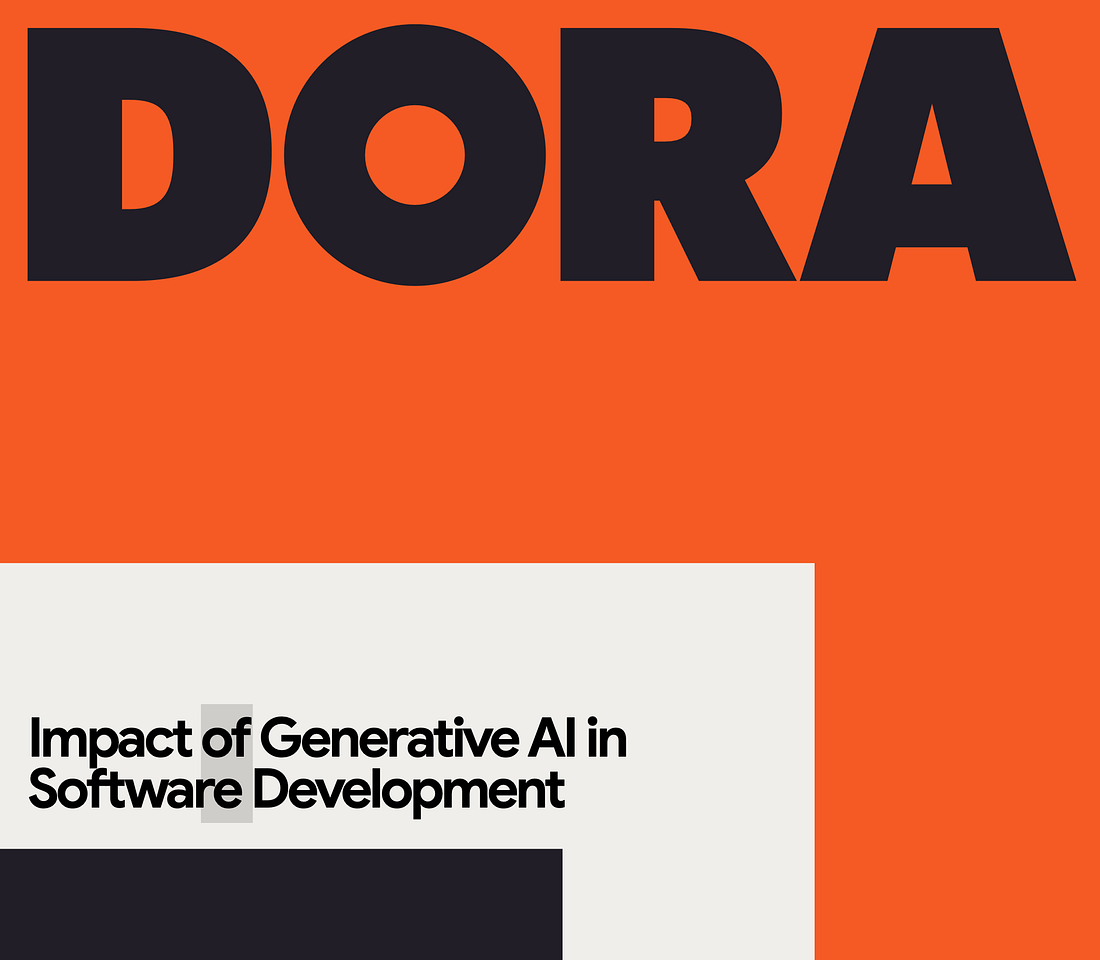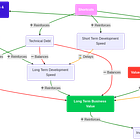What the latest DORA report says about GenAI and Software Development
- Sergio Visinoni from Sudo Make Me a CTO <makemeacto@substack.com>
- Hidden Recipient <hidden@emailshot.io>
Hi, 👋 Sergio here! Welcome to another free post from the Sudo Make Me a CTO newsletter. If you prefer to read this post online, just click the article title. As this is a free newsletter, I do immensely appreciate likes, shares and comments. That's what helps other readers discover it! What the latest DORA report says about GenAI and Software DevelopmentWhile the AI broligarchs make bold claims about the products they're selling, expert researchers help us develop a more nuanced understanding of the impact of GenAI on Software Development.This won't be the I've spent X hours reading up on Y so that you don't have to do it kind of article some of you might have gotten used to reading. I want you to read the latest DORA report¹ in its entirety. It's good for your brain, your ability to process complex topics in your head, and ultimately for your career. Beware of anyone trying to convince you to delegate those activities and just consume stripped-down summaries written by them. In most cases, they're doing it in their own interest, leveraging the innate human laziness even to make you think you should thank them for the service. You shouldn't. Feel free to read summaries, but then read the original work and form your own ideas and mental representation of it. In fact, my primary intention with this article is to convince you to read the original report. Please let me know in the comments if I succeeded. Stories and opinions about Generative AI in software development are now everywhere. The DORA report confirms that "89% of organizations are prioritizing the integration of AI into their applications, and 76% of technologists are already relying on AI". The pressure to adopt it is significant. Crazy investments are flooding the sector, and the promise of a revolution in which software engineers will become obsolete and anyone will be able to vibe-code their way to production-ready applications is repeated to exhaustion. On the one side, you have many vendors trying to convince you that their tools can do magic. Those bold claims aren't new, and though they're grounded in some level of truth, they can't conceal the inherent conflict of interest of those making them. On the other hand, you have independent researchers, such as the folks at DORA, who have been relentlessly working to help our entire industry make sense of the nuanced, complex, and still largely misunderstood discipline of software engineering. While it's easy to fall for the formers, as they tend to take up all the media space, and require minimal brain capacity to be processed, I strongly encourage any engineering leader to put in the effort to find and consume the work of researchers whose main incentive is to improve our understanding of the world; not making billions and feeding their egos. When we move past vendor promises and examine the data presented by DORA, a more nuanced and, frankly, more complex picture emerges. A picture that can't be fully captured in 280 characters, or whatever the limit on X-former-Twotter is these days. Let's look at one of the most interesting findings from the report. The Productivity ParadoxOn the surface, the report notes some appealing individual benefits. Developers using GenAI often report feeling more productive and experiencing enhanced flow states. These subjective improvements in the developer experience are undeniably part of the overall impact of GenAI on software development. However, the data reveals a significant paradox. Despite these feelings, the report also finds that increased AI adoption correlates with developers spending less time on tasks they find valuable. Time spent on toil remains largely unchanged. In essence, it suggests that GenAI might currently be better at accelerating preferred tasks than eliminating shallow and tedious work. Let's take a moment to let that sink in, as it seems counter to the repeated promises of technology. We were promised a world in which we'll have plenty of time for meaningful, creative, and fulfilling work, but the current findings suggest the opposite is happening.
Furthermore, the report highlights that "developer trust in gen AI is currently low"², acting as a significant barrier to maximizing even the perceived benefits. There are reasons for that which we need to understand fully. Simply thinking that developer trust is the problem might be an exemplary case of focusing on the proverbial finger that is pointing at the moon³. Process Gains vs. Performance PainsPerhaps the most subtle and surprising finding is the disconnect between process metrics and overall delivery performance. While AI adoption is linked to some improvements, such as potentially better documentation and faster review cycles, the report finds that "AI adoption negatively impacts software delivery performance, particularly delivery stability"⁴. How can internal processes seem faster while actual delivery outcomes suffer? This is one of those cases where focusing on individual productivity can have unexpected and undesired side effects⁵. The report suggests a plausible explanation rooted in fundamental DevOps practices.
It appears "AI improves process measures but hurts performance measures without adherence to fundamentals,"⁶ underlining that technology doesn't replace sound engineering principles – it makes them potentially even more critical. Extrapolating from the report, it hints at a potential scenario that many people in the industry underestimate or misunderstand. What the DORA report implies is that solid DevOps principles and practices, the same ones that have been found to drive overall organizational performance pre-GenAI, are a crucial requirement for increasing overall performance when integrating GenAI into the mix. So, contrary to what many voices seem to suggest, though GenAI might be lowering the bar for writing code, it's not a key differentiator when it comes to outcomes.
In other words, GenAI is more of a leveling field than a differentiator. In recent conversations, I've used an analogy that even people with no knowledge of how software is built, operated, or maintained can understand: Money in the world of entrepreneurship. Let's assume that suddenly, any single person on this planet can easily get access to funding if they want. Like ZIRP on steroids. Does that make every single person a successful entrepreneur? Is money everything required to build a successful startup? Arguably not. We've seen a good number of companies that were extremely good at burning money very quickly, but unable to make any profits. The same goes for code. Code is a key factor in building a successful tech startup, but code alone has little intrinsic value. It's a liability. More code doesn't mean more value, exactly as more money invested doesn't necessarily translate to increased ROI. There are many things you need to do right to achieve that positive transformation. Hard work is still hard work, even with a lot of money or with AI-monkeys writing most of your code. Key Takeaways for Engineering LeadersLike with any other major technological shift, we should be careful and not throw out the baby with the bathwater⁷. The DORA report also provides a set of pragmatic and evidence-based recommendations to help you guide your teams in getting the best out of AI adoption. They include the following.
Finally, the report emphasizes the need for transparency and a clear vision to ensure the maximum benefits from GenAI adoption, while addressing concerns about job security and quality of work that may be present in the organization. GenAI will never solve fundamental cultural or transparency issues at your company, but it might become the incentive you need to address those systemic problems. It's better to improve the situation for the wrong reasons, like companies improving their privacy or accessibility practices just to comply with regulations, rather than not doing it at all. Think about how you can use the hype surrounding this technological shift to address long-standing issues in your engineering practices, such as documentation, testing, continuous delivery, and the long list of capabilities DORA has been promoting for over a decade. Regardless of what the future of AI tools in software development looks like, your organization will be better positioned to benefit from them. If you enjoyed thisThis newsletter is free, and I intend to keep it free forever. Sharing it with others helps immensely in growing it. Engaging with my professional services is a great way to ensure I can continue dedicating many hours each week to producing what I hope to be high-quality content. Those services revolve around three legs:
If your needs fall into a different category, such as newsletter collaborations or sponsoring, please reply to this email or schedule a free call via this link. 1 You can download the full report here. If you prefer not to fill out the form and share your personal data, you can get the PDF from this direct link. You see, I'm making it easier for you to read the original report. You have no excuses. 2 This is a summary of the findings presented on pages 23-29. 3 In case you're unfamiliar with the old saying attributed to Confucius: "When a wise man points at the moon, the imbecile examines the finger", you can read up on it here. 4 Again, this is a summary of the findings presented on pages 5-14. 5 I wrote about another similar issue, the convenience principle, in a prior article: 6 Summary capturing the argument on pages 12-14. 7 I love how crude this saying is, but it's also very effective! Sudo Make Me a CTO is a free newsletter edited by Sergio Visinoni. If you found this post insightful, please share it with your network using the link below. If you or your company need help with one of the topics I talk about in my newsletter, feel free to visit my website where you can schedule a free 30 minutes discovery call. I'd be delighted to investigate opportunities for collaboration! |
Similar newsletters
There are other similar shared emails that you might be interested in:

